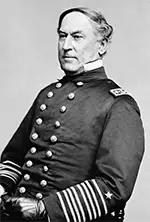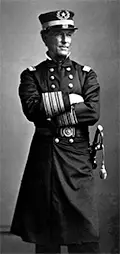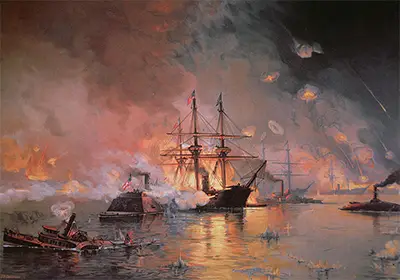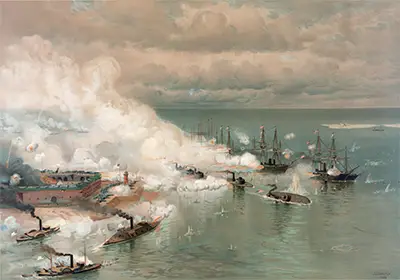David Farragut: War Hero, America's First Admiral
David Farragut was a successful naval commander during the American Civil War, capturing two prize Confederate seaports and giving the Union control of both the Mississippi River and the Gulf of Mexico. He was the first admiral in U.S. history. 
He was born James Farragut on July 5, 1801, near Knoxville, Tenn. His father, George Farragut, was a naval lieutenant during the Revolutionary War and in 1805 accepted a position at the U.S. port of New Orleans. His wife, Elizabeth, and young son accompanied him. Elizabeth died of yellow fever in 1808, and George Farragut arranged for young James to be adopted by and live with another Navy man, David Porter. In 1812, James changed his name to David in his foster father's honor and followed him to sea. The newly named David Farragut had a commission as a midshipman when he was 9. By 12, he had the rank of prize master and had fought in the War of 1812, aboard the USS Essex, under Porter's command. He was wounded, captured, and released before the war ended. He had earlier helped set up the first U.S. naval base in the Pacific, on Nuku Hiva in the Marquesas Islands. Farragut won a promotion to lieutenant in 1822, again served under Porter for a time, and two years later was given his first command, of the Ferret, serving in the Mosquito Fleet, with operations in the Caribbean and West Indies. Just before leaving, he had married Susan Marchant and made his home in Norfolk, Va. She died in 1840. He married again, in 1842, to Virginia Loyall; the couple had a son, Loyall. Farragut made the rank of commander in 1841. He served in that capacity during the Mexican-American War, commanding the USS Saratoga, but didn't see major combat. He did transport a number of seriously ill patients from the front to a base hospital in Florida. 
Continuing in the Navy, he oversaw the development of the Mare Island Naval Yard at Vallejo, near San Francisco. He was promoted to captain in 1858. As the country moved more and more toward war, he moved his family to New York, thereby declaring his allegiance to the Union. Once Fort Sumter was attacked and war was declared, President Abraham Lincoln directed the implementation of a naval blockade of the Atlantic and Gulf Coasts of the South. Farragut, promoted to Flag Officer, sailed aboard the USS Hartford in early 1862 to head up the West Gulf Blockade Squadron. Also in 1862, Farragut earned the task of taking New Orleans. Louisiana was one of the states that had seceded from the Union and formed the Confederate States of America. New Orleans was a large city at the mouth of the Mississippi River and a strategic port that both North and South wanted to control. Confederate troops had a sizable contingent of gunboats patrolling the river and had fortified the twin strongholds of Fort Jackson and Fort St. Philip. 
Farragut had his own sizable contingent of boats and troops (including his foster brother, David Porter) and began bombarding the forts on April 18, 1862. The bombardment continued for six days, during which time Union troops also severed a chain blocking passage up the river. With nothing to stop the Union boats' progress, upriver they went. Both forts surrendered on April 25, and Maj. Gen. Benjamin Butler led his infantry into the city to occupy it. In recognition of this feat, the U.S. Navy promoted Farragut to rear admiral, the first rank of admiral ever awarded in the U.S. (Government officials had wanted to avoid the trappings of royalty associated with the rank of admiral.) Farragut and his forces continued north up the Mississippi River, seizing control of other vital forts and positions, capturing Baton Rouge and Natchez and then settling in to patrol the river, preventing Confederate forces to reinforce other positions, particularly Vicksburg and Port Hudson. Union forces under Ulysses S. Grant took Vicksburg on July 4, 1863, after a long siege, and Port Hudson fell to Union forces five days later. Farragut had run his boats past both locations earlier but, without enough land forces, could not take control of either. (In fact, Farragut had made a rare blunder at Port Hudson that took his ships out of the fighting, prolonging that siege.) With the Mississippi River firmly in Union hands, Farragut then set his ships' sights on Mobile, Ala., the last open seaport to the Gulf of Mexico. Heavily defended as well, the industrial port city at the mouth of Mobile Bay was heavily defended by a number of warships, controlling the entrance to Fort Morgan and Fort Gaines; in addition, Confederate troops had planted a large torpedo mine field. With large amounts of force available, Farragut put together a large attack fleet consisting of 14 warships and four ironclads. Waiting inside the protective ring of the mine field were Confederate Admiral Franklin Buchanan commanding three gunboats and the CSS Tennessee, an ironclad. 
The Union ships advanced. The USS Tecumseh sank after hitting a mine. The next ship, the Brooklyn stopped its advance. Farragut, aboard the Hartford bellowed, "Damn the torpedoes! Full speed ahead!" and ordered the assault to continue. He had himself lashed to the rigging so others could see his determination to continue the fight. His forces rallied and followed him. The rest of the Union ships made it through the mine field without sinking, and the ship-to-ship battle commenced. The superior Union numbers turned the tide, and the Confederate ships surrendered. Not long afterward came the surrender of the fort and then the city. Farragut, furloughed because of failing health, returned home to a hero's welcome. Lincoln promoted Farragut to vice admiral on Dec. 21, 1864. The veteran commander made a full recovery and returned to duty along the James River. When Richmond, the Confederate capital, fell, Farragut and Maj. Gen. George Gordon were among the first to enter the city. Congress created the rank of full admiral after the war and promoted Farragut to that status in 1866. He went on a European tour the following year. The remained in the Navy but did not sail again. He died of a stroke on Aug. 14, 1870, while vacationing at Portsmouth, N.H. He was 69. Marching in his funeral procession were President Grant and more than 10,000 sailors and soldiers. Honoring Farragut have been a statue and prominent square in Washington, D.C.; two classes of U.S. Navy destroyers; a military academy; two postage stamps; and a Treasury Note. |
|
Social Studies for Kids
copyright 2002–2024
David White




